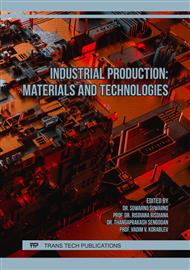[1]
Shtyrev O. Causes of destruction of the drill pipe body during operation and the advantages of drill pipes with an internal protective coating / Territoriya neftegaz. 2014. № 12.
Google Scholar
[2]
Korchagin A. P et al. Destruction of drill pipe nipples during operation / Territory Neftegaz. 2016. №11. [In Russian].
Google Scholar
[3]
Plessis G., Wright C., Aranas A., Jellison M. J., Muradov A. Drill pipe Fatigue in a fast-drilling environment: how to cope with the extreme! /IADC/SPE Asia Pacific Drilling Technology Conference and Exhibition. OnePetro. 2006.
DOI: 10.2118/103908-ru
Google Scholar
[4]
Ermakov B., Alkhimenko A., Kharkov A., Shvetsov O., Davydov A. Investigating the influence of temperature on the selection of criteria for evaluating the propensity of tube steels to corrosion cracking at low loading speeds / E3S Web of Conferences. 2021.
DOI: 10.1051/e3sconf/202122501001
Google Scholar
[5]
Davydov A., Erokhina O., Ryaboshuk S., Kovalev P. Analysis of the Causes of Cracks in the Production of Ingots and Forgings from Austenitic Stainless Steel 08Cr18Ni10Ti (AISI 321) / Key Engineering Materials. 2020. pp.16-22.
DOI: 10.4028/www.scientific.net/kem.854.16
Google Scholar
[6]
Utevsky L., Glikman E., Kark G., Reversible tempering brittleness of steel and iron alloys / Metallurgizdat. 1987. 222 p. [In Russian].
Google Scholar
[7]
Aleksandrov Yu., Aginay R. Topical issues of corrosion protection of main gas and oil pipelines / St. Petersburg: Nedra. 2012. 400 p. [In Russian].
Google Scholar
[8]
Mustafin F., Kuznetsov M., Bykov L. Construction of pipelines / Corrosion protection: Volume 1, Monograph. 2004. 609 p. [In Russian].
Google Scholar
[9]
Fares Y. Determining the life cycle of bolts using a local approach and the Dang Van criterion / Fatigue & Fracture & Engineering Materials & Structures. 2006. № 29. pp.588-596.
DOI: 10.1111/j.1460-2695.2006.01029.x
Google Scholar
[10]
Macdonald K. Failure analysis of drillstrigs / Engineering Failure Analysis. 2007. №14. p.1641–1666.
Google Scholar
[11]
Pesin M. Scientific principles of modeling the process of hardening the thread cavity of drill pipes by rolling with a roller / Exposition Oil Gas. 2013. № 5 (30), pp.68-70. [In Russian].
Google Scholar
[12]
Pesin M. Improving the Reliability of Threaded Pipe Joints / Russian Engineering Research. 2012. Vol. 32, №2. pp.210-212.
DOI: 10.3103/s1068798x12020232
Google Scholar


